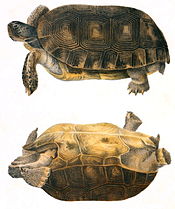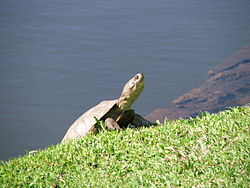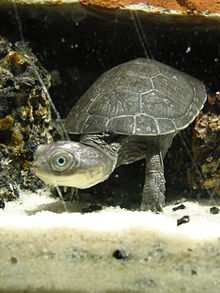- African helmeted turtle
-
African helmeted turtle Conservation status Scientific classification Kingdom: Animalia Phylum: Chordata Class: Reptilia Order: Testudines Suborder: Pleurodira Family: Pelomedusidae Genus: Pelomedusa Species: P. subrufa Binomial name Pelomedusa subrufa
(Lacépède, 1788)The African helmeted turtle or Marsh terrapin (Pelomedusa subrufa), is typically a rather small turtle with most individuals being less than 87.9 cm in carapace length, but one has been recorded with a carapace length of 132.5 cm. it has an black or brown carapace (shell). The tops of the tail and limbs are a grayish brown, while the underside is yellowish. The male turtle is distinguished by its long, thick tail. Females tend to have a shorter tail and a broader carapace. Hatchlings have a shell size of about 1 and 1/4 inches in length, and are olive to black in color. It also has two small tubercles under the chin and musk glands in the sides of the carapace. The African helmeted turtle doesn't have a hinged plastron (lower shell). All the other species in the family Pelomedusidae however have this feature which they can, using muscles, close to cover their head and front limbs.
Contents
Diet
The African helmeted turtle is omnivorous and will eat almost anything. Some of the main items in its diet are insects, small crustaceans, fish, earthworms, and snails. They may also feed on carrion. The fine claws on its feet help it tear its prey apart. Groups of these turtles have been observed capturing and drowning doves when they come to drink.
Habitat and Distribution
The range of Pelomedusa subrufa spreads over a large portion of Africa. It can be found as far west as Ghana and as far south as Cape Town. It has also been found in Madagascar and Yemen. They are semi-aquatic animals, living in rivers, lakes, and marshes, and they also like rain pools and places that are fertilized.
Reproduction
Courtship is held all over the year. The male will follow the female nodding his head in front of hers. If she is non-responsive she will nip and snap and walk away. If she is willing, she responses nodding her head or just stands still, he can sit onto her. While mating both of the turtles shake their head.
The female will lay 2 to 10 eggs on average, normally during late spring and early summer. The eggs are placed in a flask shaped nest that is about 4 to 7 inches deep. The eggs hatch in 75– 90 days.
References
- Richard C. Boycott and Ortwin Bourquin: The southern African Toirtoise Book – A Guide to southern African Tortoises, Terrapins and Turtles, O. Bourqin, KiwaZulu-Natal 2000, ISBN 0-620-26536-1
Order Testudines (turtles) Suborder SuperfamilySubfamily
Cryptodira Caretta · Chelonia · Eretmochelys · Lepidochelys · NatatorDermochelysDermatemydidaeDermatemysStaurotypinaeBatagur · Cuora · Cyclemys · Geoclemys · Geoemyda · Hardella · Heosemys · Leucocephalon · Malayemys · Mauremys · Melanochelys · Morenia · Notochelys · Orlitia · Pangshura · Rhinoclemmys · Sacalia · Siebenrockiella · VijayachelysAldabrachelys · Astrochelys · Chelonoidis · Chersina · Cylindraspis · Geochelone · Gopherus · Homopus · Indotestudo · Kinixys · Malacochersus · Manouria · Psammobates · Pyxis · Stigmochelys · TestudoTrionychiaCarettochelyidaeCarettochelysTrionychinaePleurodira ChelidinaeChelodininaeHydromedusinaePhylogenetic arrangement based on turtles of the world 2010 update: annotated checklist. Extinct turtles not included.
See also List of Testudines families
 Portal ·
Portal ·  WikiProjectCategories:
WikiProjectCategories:- IUCN Red List least concern species
- Pelomedusa
- Reptiles of South Africa
- Fauna of Madagascar
- Turtle stubs
Wikimedia Foundation. 2010.




